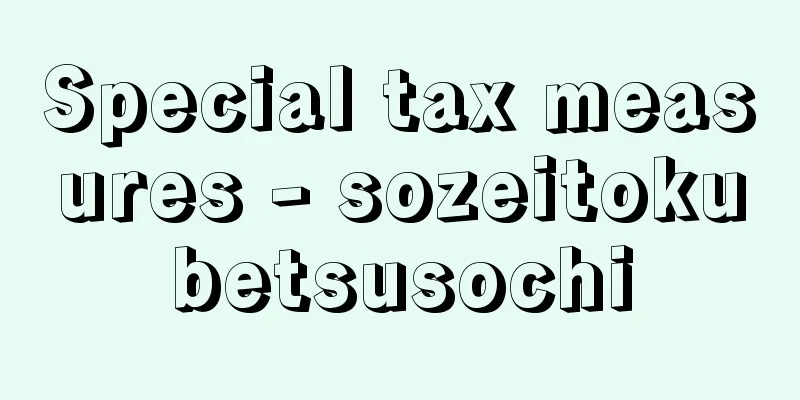Special tax measures - sozeitokubetsusochi

|
Based on policy perspectives such as economic policy and industrial policy, in many cases, without amending the basic tax law, special laws are used to temporarily or exceptionally change part of the law's application, thereby reducing, exempting, or heavier the tax burden on specific industrial sectors or taxpayer classes (however, special tax measures are also included in each basic tax law). Tax cuts using special tax measures are sometimes called policy tax cuts, as opposed to general tax cuts that amend the basic tax law itself. In Japan, it was with the Temporary Tax Measures Law of 1938 (Showa 13) that special measures began to be stipulated in special laws. During World War II, the number of special measures expanded to over 40 items, but many of them were abolished after the war. The Shoup recommendations (1949), which are the origin of the postwar tax system, also recommended the abolition of special measures, but thereafter, special measures began to increase again, and by the time they were compiled into the Special Taxation Measures Law of 1957 (Showa 32), there were over 30 items. The policy objectives of special tax measures at that time were to correct corporate capital structures, increase internal reserves, encourage savings, promote exports, promote technology, modernize corporate facilities, and support growing industries, but most of them were aimed at promoting capital accumulation. In other words, the aim was to rebuild capital destroyed by war and inflation through the inducement of tax exemptions. While this objective was achieved, it also created a disparity in which large corporations, high-income earners, and those with strong political influence benefited from the special measures while small and medium-sized enterprises and low-income earners did not. Based on the tax reduction or exemption effect, special tax measures can be divided into two categories. The first type is one that permanently reduces the amount of tax paid. This includes measures to reduce tax rates, expand the scope of expenses that can be deducted or excluded from taxable income, and tax credits. The second type is one that defers taxation. These include special depreciation and reserve systems, both of which encourage investment by allowing companies to accumulate internal reserves more quickly than if these measures were not allowed. There is a principle of fairness in taxation. Special tax measures are a major exception to this principle, which states that people with the same income should pay the same tax. It has been criticized that we must always consider whether the objectives being pursued are truly necessary for the people and whether the measures are effective in achieving those objectives, but this consideration was hardly carried out. However, as we entered the era of low growth after the oil shock, the reality of an absolute shortage of tax revenues finally led to the review, amendment, and abolition of special tax measures. [Tetsuya Hitosugi] [References] | | |Source: Shogakukan Encyclopedia Nipponica About Encyclopedia Nipponica Information | Legend |
|
経済政策や産業政策などの政策的な見地に基づいて、多くの場合、基本税法を改定することなく、特別法によってその適用の一部を臨時的、例外的に変更して、特定の産業部門、納税者層の税負担を軽減・免除あるいは重くする措置をいう(ただし、租税特別措置は各基本税法のなかにも含まれている)。基本税法そのものを改定する一般減税に対して、租税特別措置による減税を政策減税ということもある。 日本で特別法でこれを規定するようになったのは、1938年(昭和13)の臨時租税措置法からである。第二次世界大戦中に特別措置は拡大されて四十数項目に達したが、戦後その多くは廃止された。戦後租税体系の原点たるシャウプ勧告(1949)も特別措置の撤廃を勧告していたが、その後、特別措置はふたたび増加し始め、1957年(昭和32)の租税特別措置法に集大成されるときには三十数項目に及んだ。この当時の租税特別措置の政策目的は、企業の資本構成の是正、内部留保の充実、貯蓄の奨励、輸出の促進、技術振興、企業設備の近代化、成長産業の助成などであるが、その多くは資本蓄積促進のためのものであった。すなわち、戦争とインフレーションによって破壊された資本を、租税の減免という誘因によって復興しようとするものであり、その目的は達成された反面、大企業、高所得者、そして政治的発言力の強い者ほど特別措置の利益に浴し、中小企業、低所得者ほど利益を受けられないという格差を発生させた。 こうした税の減免効果から、租税特別措置は二つに分類できる。第一は永久に納税額を軽減するものである。それには税率を軽減するもの、損金算入や益金不算入の範囲を拡大するもの、税額を控除するものなどがある。第二は課税を繰り延べるものである。これには特別償却と準備金制度があり、いずれもこれを認められない場合に比べて内部留保を早く蓄積できるから、投資が促進される。 課税には公平の原則といわれるものがある。同一の所得の状況にある者は同一税を負担するというこの原則に、租税特別措置は重大な例外となるので、追求される目的が真に国民にとって必要なものか、その目的達成のためにその措置が有効かどうかをつねに検討しなければならないと批判され続けてきたが、この検討はなかなか実行されなかった。しかし、オイル・ショック後の低成長時代に入ると、税収の絶対的不足という現実から、ようやく租税特別措置の見直し・改廃が行われるようになった。 [一杉哲也] [参照項目] | | |出典 小学館 日本大百科全書(ニッポニカ)日本大百科全書(ニッポニカ)について 情報 | 凡例 |
<<: Tax offender - tax offender
>>: Plastic design method - Soseisekkeiho (English spelling) plastic design
Recommend
Puppet show
Puppet theatre is characterized by actors (puppet...
Sir Arthur Stanley Eddington
British astronomer and theoretical physicist. Bor...
Rear Admiral Katano
The protagonist of the story. He is depicted as a ...
Korea
...Yi Dynasty scholar Li Yi Yi interpreted Jo as ...
Tap dance
A form of dance. It developed in the United States...
sauce vinaigrette
...A sauce made by adding hard-boiled eggs, chopp...
The Great Master - Odai no kata
⇒Dentsuin Temple Source: Kodansha Digital Japanese...
Sea steps - Kaidan
… plateau A flat or nearly flat area of conside...
Conversion - Tenko
(1) In the broad sense, it means a change from on...
Fountain tower - Funsentou (English spelling) Sinter cone
A tower made of precipitates such as travertine or...
Mimulus sessilifolius (English spelling) Mimulussessilifolius
… [Mitsuru Hotta]... *Some of the terminology tha...
Pyramid - Pyramid
If there is a polygon P on a plane α and a point ...
havne
...The coastal areas of the country were therefor...
Inheritance tax - death duty
A tax levied on assets acquired through inheritan...
Tilden, Samuel Jones
Born: February 9, 1814, New Lebanon, New York [Die...







![Altun [Mountains] - Altun](/upload/images/67cade90df23a.webp)

